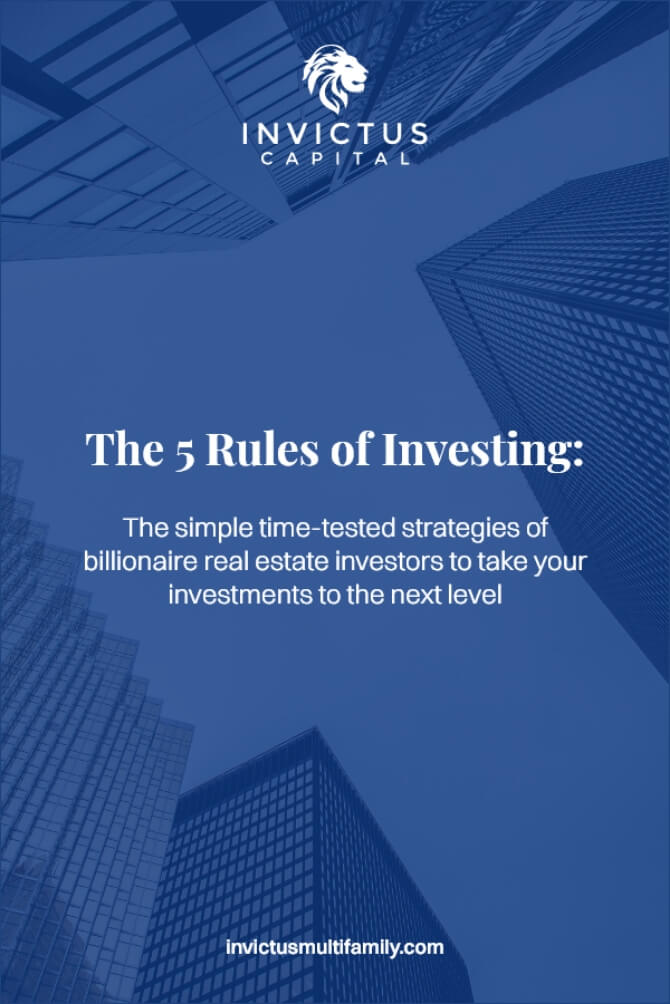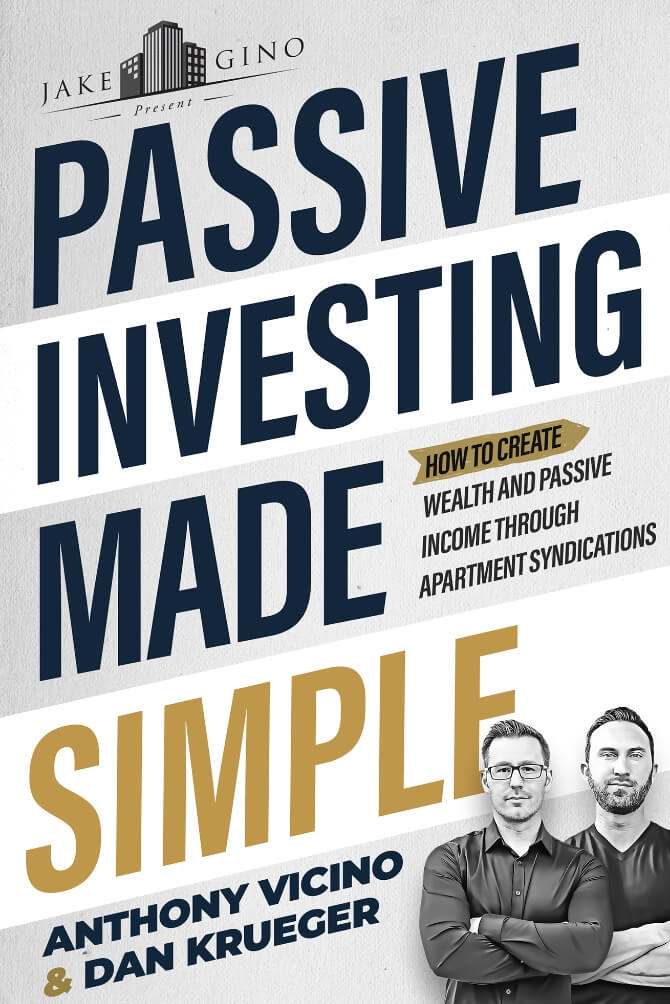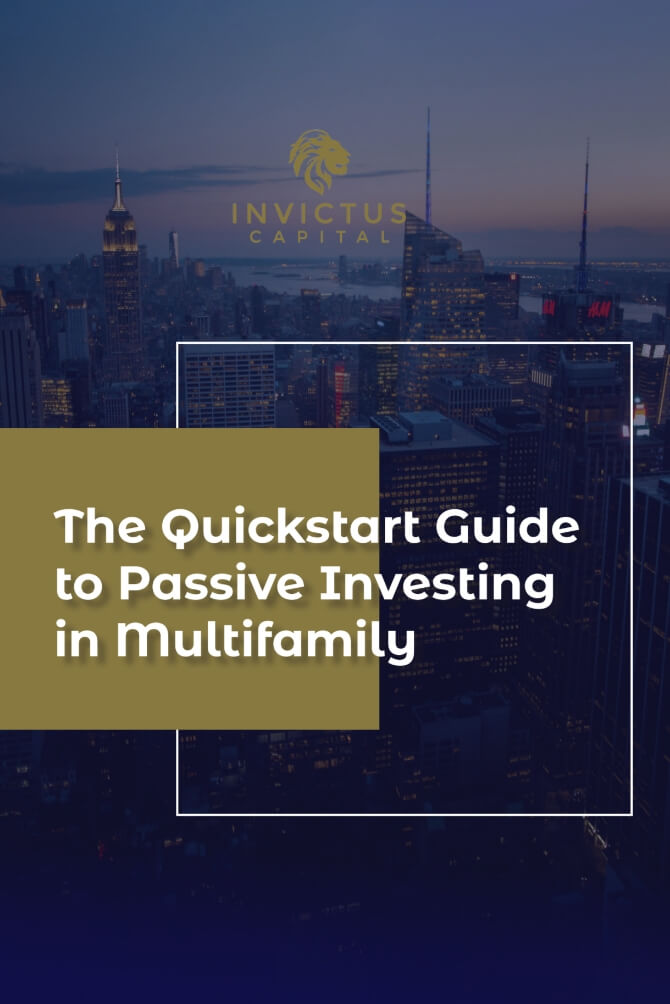For today’s episode, we will be discussing infinite returns.
We will go over being able to make money without having any capital at risk.
We will talk about these things…and more in another episode of Multifamily Investing Made Simple in under 10 minutes.
Tweetable Quotes:
“When that denominator drops to zero, your capital invested is zero. You got your initial capital out of that denominator goes to zero. You cannot calculate your ROI anymore because the denominator zero” – Dan Kreuger
“you’re in the deal for zero dollars like you’re getting an infinite return. The problem with that is you have 100 percent leverage.” – Anthony Vicino
“so the first part of that for me would be getting the cash flow machine going that I can then use to dump into the real estate” – Anthony Vicino
LEAVE A REVIEW if you liked this episode!!
Keep up with the podcast! Follow us on Apple, Stitcher, Google, and other podcast streaming platforms.
To learn more, visit us at https://invictusmultifamily.com/
**Want to learn more about investing with us?**
We’d love to learn more about you and your investment goals. Please fill out this form and let’s schedule a call: https://invictusmultifamily.com/contact/
**Let’s Connect On Social Media!**
LinkedIn: https://www.linkedin.com/company/11681388/admin/
Facebook: https://www.facebook.com/invictuscapitalventures/
YouTube: https://bit.ly/2Lc0ctX

How to Generate Infinite Returns in Under 10 Minutes
How to Generate Infinite Returns in Under 10 Minutes_processed.mp3
Anthony Vicino: [00:00:15] it Hello, welcome to Multifamily Investing, made simple in Under 10 Minutes is a podcast where we take the complexity out of real estate investing so that you can take action today and you like that Internet that it ran through. Yeah, I’m working on here.
Dan Krueger: [00:00:31] And then it got up to like a four. I don’t think we got up to a ton. But for you, that was impressive. When we do
Anthony Vicino: [00:00:38] These intros, we kind of just getting into the groove and just mundanes every time. It’s the same thing. I wanted to put a little bit of character, a little bit of pizzazz into there. So always trying to learn Spanish. The problem with that, and it’s not what you would think, it’s the fact that I don’t speak Spanish. Maybe that is a problem, that maybe I agree with that, but
Dan Krueger: [00:01:03] It seems irrelevant.
Anthony Vicino: [00:01:04] Let’s talk about what we’re here to talk about, which is infinite returns. Oh, like that sounds pretty good, right? Like I want an infinite return. Now, this isn’t just clickbait, right, like we actually have something underlying this that is interesting and compelling for a real estate investor at home to know more about. Right. We didn’t just bait and switch them.
Dan Krueger: [00:01:27] Yeah, and it’s important to notice for any of the people who are looking for life insurance information, we’re not trying to bait and switch, we’re not going to talk about that. If you look at oh, no insurance, infinite banking, wrong video, keep going.
Anthony Vicino: [00:01:39] We’re talking about something
Dan Krueger: [00:01:40] Else, which I think is actually cooler.
Anthony Vicino: [00:01:42] All right. So walk me through infinite returns. And what do we mean by that? Because this is a term that we use occasionally when we’re talking to investors to get their appetite, like, oh, that sounds really cool, get them on the hook, so to speak.
Dan Krueger: [00:01:57] Yeah. The example I like to use when describing this concept, people and honestly, we don’t use infinite returns much because it’s got a little bit of a buzz word nature to it. It sounds flippity and. Yeah, but maybe it is going to get people to click on this video. So I used it today. But what we’re really talking you’re here
Anthony Vicino: [00:02:13] Listening in are
Dan Krueger: [00:02:16] Being able to make money without having any capital at risk. So the way I like to describe this concept to people is through an analogy that I think most people should be able to wrap their heads around regardless of whether they understand real estate or not. So let’s say you go into the casino and you put down a hundred bucks for the blackjack table and you win one hundred bucks on your first hand. And you take that out, you take your winnings out your hundred bucks and you keep playing with what is now known as house money, your winnings from that first hand, you took the money out that you put in and that was your capital that you had to risk. It is now off the table and is not at risk anymore. And you continue to play and let’s just say you do pretty well with more money off of that one hundred bucks that the casino gave you, those would be infinite returns. When that denominator drops to zero, your capital invested is zero. You got your initial capital out of that denominator goes to zero. You cannot calculate your Arawa anymore because the denominator zero, and that’s why we call it infinite returns. But today we’re going to do a little bit more of a deep dive on how that works in real estate, which is pretty cool.
Anthony Vicino: [00:03:22] Yeah. And the thing here is there’s a couple of different ways that you could generate an infinite return. One would just be to buy a deal with absolutely none of your own money with money. There’s none like if you could get one hundred percent financing, you’re in the deal for zero dollars like you’re getting an infinite return. The problem with that is you have 100 percent leverage. That’s really risky. That’s really scary. And so we don’t recommend that path. There are some operators out there that like to leverage up to the hilt so that they can get close to that infinite return. But we are not those people. We’re very risk-averse. So we like to keep our debt coverage ratio nice and beefy. So that leaves us with one other way of really getting that infinite return, and that’s to the cash-out refinance. So if you’ve listened to us before, you’re familiar with value add multifamily real estate. But if this is your first time listening to this, let’s just quickly walk through how this works. When we buy an apartment building, the way these things are valued is as a function of that building’s net operating income divided by what’s called a cap rate. So let’s put aside the cap rate right now because that’s what can be confusing. No, it’s a multiplier. It’s a way of calculating the building’s value. And so when we go in and acquire these assets, our goal is to improve that a wide.
Anthony Vicino: [00:04:43] By doing that, we can make our buildings more valuable. Now, the way that we do that is we increase the revenue or we decrease the expenses. Those are the two ways to improve in a way. And once we do that, if we go into a property and we renovate the units, we make them snazzier and then we start charging two hundred dollars more in rent per month. Well, we’ve just added a ton of value. And so then what we do is we go to the bank and we say, hey, are buildings worth more? Now, we did all this work, we increased the revenue, we decrease the expenses. We would like you to refinance us. And the bank says, sounds good. It does look like it’s worth more. And so now they give us a loan for that new higher amount. We pay back our old lower amount loan and we make the difference and we pay back ourselves. We pay back our investors. And now we have no more money in the deal. Hence, from that point forward, all cash flow, all distributions, it’s an infinite return. So let’s maybe let’s get into some numbers because that cash-out refinance was always kind of confusing to me. I tried to explain it with words and not numbers because the numbers kind of confused me. But now that we have the base, let’s layer some numbers in there.
Dan Krueger: [00:05:55] Let’s do it. Try to keep it simple, so know people are listening to this as opposed to watching it. Those of you watching, you can just look at us. But for those of you listening, I’m going to try to make this as simple as possible so you could just listen to these numbers. And it’s not confusing. Let’s say you buy a house is a house. You get a house for one hundred thousand dollars. You put twenty-five percent up, so you put down twenty-five thousand dollars to buy the house, four hundred thousand dollars and you know. And this is a bad example because I’m using the house and the house isn’t valued based on a lie, but we’re going to ignore that for the sake of simplicity just so we can use something small and something people can wrap their heads around pretty easily. Let’s pretend like this house is valued off. It’s a… I just like an apartment building is. So let’s say you buy this place and you know, you can fix it up for, let’s say, twenty-five thousand dollars. You paint it, you’re going to put new appliances in and you’re going to make it way better than it was when you got it.
Dan Krueger: [00:06:59] And once you do that, it’s going to be worth one hundred and seventy-five thousand dollars. So you buy your house for twenty-five thousand dollars down, you put twenty-five thousand dollars into renovations, so you’re into it. Fifty thousand dollars down payment of twenty-five thousand plus twenty-five thousand dollars of rehab costs, you’re into it for fifty thousand dollars and you go back to the bank after a year or however long it takes you. You say, Hey, Mr. Banker, I just made this place way better. I’d like to refinance. And you find out that it’s not worth one hundred seventy-five thousand dollars. So you get a loan out on that new higher value. Let’s say again, it’s seventy-five percent, just like your first loan. That means that the new loan is going to be one hundred and thirty-one thousand dollars and two hundred fifty dollars. That’s seventy-five percent of the new value. One hundred seventy-five thousand dollars. Your new loan is one hundred thirty-one thousand two hundred fifty. Your old loan was. Seventy-five thousand. Well, now it’s right down to like seventy-three thousand dollars now because you have to pay them.
Dan Krueger: [00:08:02] Yeah. So let’s just say you’ve had it for a year and you’ve paid off some of that. So now it’s down to seventy-three thousand. So we take our proceeds from the REIFY, which is the new loan minus the old balance, and that nets us fifty-eight thousand two hundred fifty dollars. And you put in fifty thousand dollars and you just got fifty-eight thousand two hundred fifty back, which means all of your initial investment is back in your pocket. You can go get a deal. You still own the property. So you’re still going to be getting cash flow checks, albeit a little bit smaller than before, because the debt service is higher. But at this point, you’re not over-leveraged. You have a seventy-five percent loan and you’ve got no more money in the deal. And so your returns are infinite. And so let’s say you’re getting, you know, five, 10 grand a year off of this deal and you wanted to calculate what your cash on cash return is. You can’t because you’re down to zero. There’s no money in the deal. You can’t calculate the rate of return. And that is what we call an infinite return.
Anthony Vicino: [00:08:57] And it’s so great this the strategy because infinite returns are it sounds really cool and it is. But what’s even cooler to me is that you now have an entirely d risked investment. You own this thing and you are still at a seventy-five percent loan to value. Let’s say like we’re not leveraged up to the hilt. We have all of our money out of it and it’s still generating cash flow. That’s a risky investment that’s really hard to beat. And I, I love it because the way that we talk about this sometimes is most people are familiar with fix and flip like single-family homes that you see on TV where they go in and they buy the chanty, they fix it up and they then sell it to recoup all that new equity that they built up. But with our strategy, what we do is we don’t sell it, we refinance it. So we still hold on to it. It continues generating it. It’s like the win-win-win of all wins.
Dan Krueger: [00:09:51] Yeah, one of the biggest reasons why that’s a win-win-win is because you keep getting those cash flow checks, which is great. We’ve talked about all the time that the cash flow component is such an important part of being financially stable, having some kind of reoccurring paycheck coming in. But then the biggest one is those people that turn around and sell right away. Well, they got to pay capital gains taxes on those profits, whereas for a refinance, it’s a nontaxable event. You get to pull your money out, get that cash in hand in a tax-free capital event, go out and redeploy that without having to pay the taxman. So that Flipper who turned around and sold that thing, has to pay the taxes on that thing and they only get to reinvest what’s leftover, whereas you could save that money and put it all to work and not have to pay the taxman until you actually sell the building much later, if ever.
Anthony Vicino: [00:10:42] So if you thought infinite returns are good, let me just blow your mind with this concept. So we did this with our first property. Right. We refinanced. We got all our money back plus some. And then like down said we going to redeploy that in deal number two. So we have now acquired two deals with the same amount of money, the same dollars, just like a bank would do. And now let’s say we do the same thing again, where we add value to the property number two and we refinance it and we get all that money back again. Now we have double infinite returns.
Dan Krueger: [00:11:15] We’ll triple because they’ll take that and buy a third property.
Anthony Vicino: [00:11:17] Oh, my God, we have infinite, infinite returns. It’s like infinite regression.
Dan Krueger: [00:11:21] It’s a really powerful strategy. And that’s why we keep doing it over and over again. It works really well. It’s low risk because of all the things we named. You’re not leverage. You’re just using your capital as efficiently as possible. And the biggest thing I think is the tax component. If you don’t have to take that tax burden on to get your money, then that’s extremely powerful because that tax drag is huge. I mean, if you’re paying 30 to 50 percent in taxes every time you make money, extrapolate that out for thirty years and then compare it to a guy who doesn’t have to do that. And the guy who doesn’t have to do that is going to have a whole bunch of extra zeros and commas in his number at the end of thirty years than the guy who’s flipping and paying taxes every time.
Anthony Vicino: [00:12:02] Mhm. So that is the infinite return. Hopefully, you got a little bit of value out of this episode. You don’t feel like you are bait and switch. You weren’t baited. Well, we did. Do we want to get you in here because that’s fun? The more people at the party the more fun I get. I hate parties
Dan Krueger: [00:12:22] So and I wouldn’t be for me it
Anthony Vicino: [00:12:24] Wouldn’t be fun for me at all. But we appreciate your take a little bit of time out of your day and we’re going to look forward to seeing you next week. Do we have anybody, in particular, we want to call out to go leave a review? Friend does. And Jeremiahs,
Dan Krueger: [00:12:37] Can we get Jeremiahs in there?
Anthony Vicino: [00:12:38] Yeah. Jeremiahs, you’ve been slacking recently. Jeremiahs, Brenda’s Carlile’s go leave a review over on iTunes. The rest of you also maybe think about leaving a review but just know it’s not your time quite yet. You know.
Dan Krueger: [00:12:49] How many Carlile’s do you think or. Listen to I if you’re listening
Anthony Vicino: [00:12:52] To this and your name’s Carlyle, shoot me a message. I got something for you. It’s not weird. I got a book for you. You get a free copy of passive investing made. Simple. I’m going to send it out to you if your name’s Carlyle, just for being a Carlyle. There has to be first name, no last name, and
Dan Krueger: [00:13:08] Sounds like a good, but
Anthony Vicino: [00:13:09] It’s fantastic and not just because I wrote it, but that’s going to be a fresh guy. We’ll see you next week.


